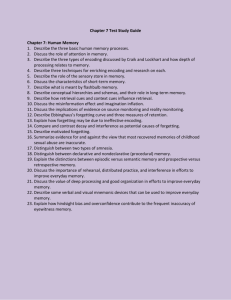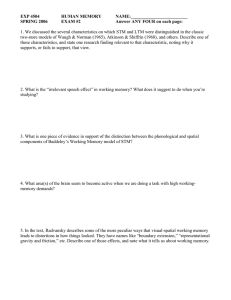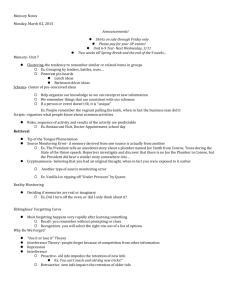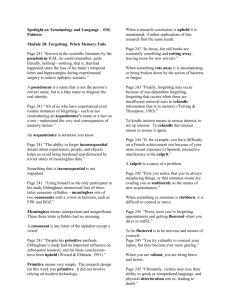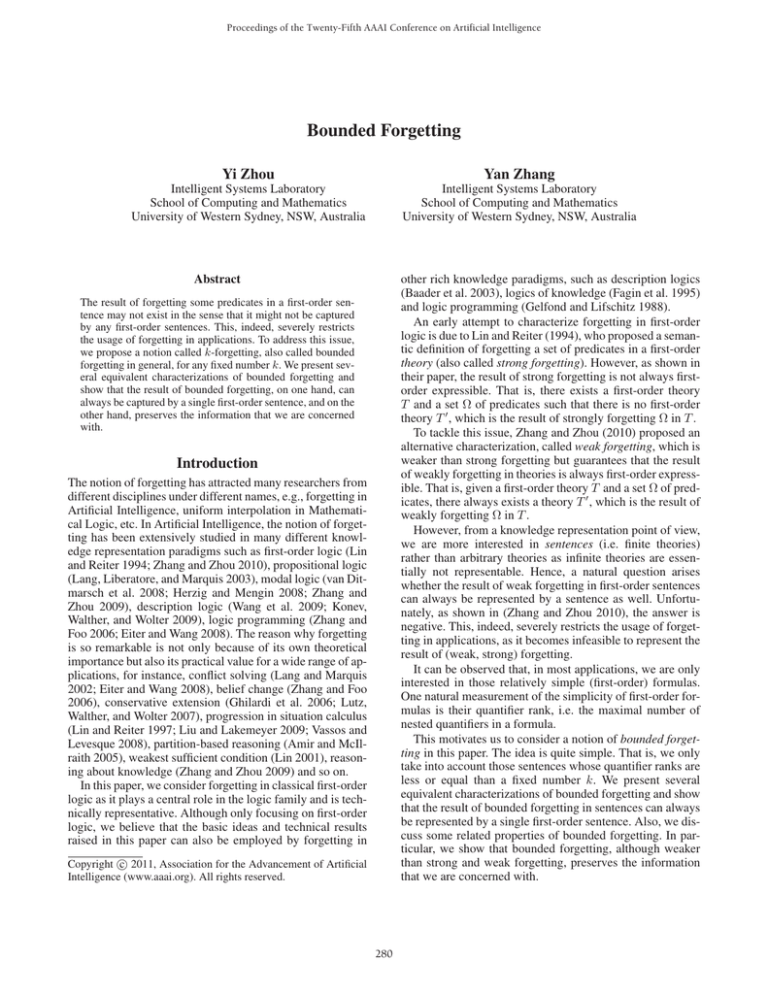
Proceedings of the Twenty-Fifth AAAI Conference on Artificial Intelligence
Bounded Forgetting
Yi Zhou
Yan Zhang
Intelligent Systems Laboratory
School of Computing and Mathematics
University of Western Sydney, NSW, Australia
Intelligent Systems Laboratory
School of Computing and Mathematics
University of Western Sydney, NSW, Australia
other rich knowledge paradigms, such as description logics
(Baader et al. 2003), logics of knowledge (Fagin et al. 1995)
and logic programming (Gelfond and Lifschitz 1988).
An early attempt to characterize forgetting in first-order
logic is due to Lin and Reiter (1994), who proposed a semantic definition of forgetting a set of predicates in a first-order
theory (also called strong forgetting). However, as shown in
their paper, the result of strong forgetting is not always firstorder expressible. That is, there exists a first-order theory
T and a set Ω of predicates such that there is no first-order
theory T , which is the result of strongly forgetting Ω in T .
To tackle this issue, Zhang and Zhou (2010) proposed an
alternative characterization, called weak forgetting, which is
weaker than strong forgetting but guarantees that the result
of weakly forgetting in theories is always first-order expressible. That is, given a first-order theory T and a set Ω of predicates, there always exists a theory T , which is the result of
weakly forgetting Ω in T .
However, from a knowledge representation point of view,
we are more interested in sentences (i.e. finite theories)
rather than arbitrary theories as infinite theories are essentially not representable. Hence, a natural question arises
whether the result of weak forgetting in first-order sentences
can always be represented by a sentence as well. Unfortunately, as shown in (Zhang and Zhou 2010), the answer is
negative. This, indeed, severely restricts the usage of forgetting in applications, as it becomes infeasible to represent the
result of (weak, strong) forgetting.
It can be observed that, in most applications, we are only
interested in those relatively simple (first-order) formulas.
One natural measurement of the simplicity of first-order formulas is their quantifier rank, i.e. the maximal number of
nested quantifiers in a formula.
This motivates us to consider a notion of bounded forgetting in this paper. The idea is quite simple. That is, we only
take into account those sentences whose quantifier ranks are
less or equal than a fixed number k. We present several
equivalent characterizations of bounded forgetting and show
that the result of bounded forgetting in sentences can always
be represented by a single first-order sentence. Also, we discuss some related properties of bounded forgetting. In particular, we show that bounded forgetting, although weaker
than strong and weak forgetting, preserves the information
that we are concerned with.
Abstract
The result of forgetting some predicates in a first-order sentence may not exist in the sense that it might not be captured
by any first-order sentences. This, indeed, severely restricts
the usage of forgetting in applications. To address this issue,
we propose a notion called k-forgetting, also called bounded
forgetting in general, for any fixed number k. We present several equivalent characterizations of bounded forgetting and
show that the result of bounded forgetting, on one hand, can
always be captured by a single first-order sentence, and on the
other hand, preserves the information that we are concerned
with.
Introduction
The notion of forgetting has attracted many researchers from
different disciplines under different names, e.g., forgetting in
Artificial Intelligence, uniform interpolation in Mathematical Logic, etc. In Artificial Intelligence, the notion of forgetting has been extensively studied in many different knowledge representation paradigms such as first-order logic (Lin
and Reiter 1994; Zhang and Zhou 2010), propositional logic
(Lang, Liberatore, and Marquis 2003), modal logic (van Ditmarsch et al. 2008; Herzig and Mengin 2008; Zhang and
Zhou 2009), description logic (Wang et al. 2009; Konev,
Walther, and Wolter 2009), logic programming (Zhang and
Foo 2006; Eiter and Wang 2008). The reason why forgetting
is so remarkable is not only because of its own theoretical
importance but also its practical value for a wide range of applications, for instance, conflict solving (Lang and Marquis
2002; Eiter and Wang 2008), belief change (Zhang and Foo
2006), conservative extension (Ghilardi et al. 2006; Lutz,
Walther, and Wolter 2007), progression in situation calculus
(Lin and Reiter 1997; Liu and Lakemeyer 2009; Vassos and
Levesque 2008), partition-based reasoning (Amir and McIlraith 2005), weakest sufficient condition (Lin 2001), reasoning about knowledge (Zhang and Zhou 2009) and so on.
In this paper, we consider forgetting in classical first-order
logic as it plays a central role in the logic family and is technically representative. Although only focusing on first-order
logic, we believe that the basic ideas and technical results
raised in this paper can also be employed by forgetting in
c 2011, Association for the Advancement of Artificial
Copyright Intelligence (www.aaai.org). All rights reserved.
280
Strong and Weak Forgetting
cases, there is no first-order sentence ψ, which is equivalent to WF (φ, Ω). In this case, we also say that the result of
weakly forgetting Ω in φ does not exist.
The relationships between strong forgetting and weak forgetting are discussed in detail by Zhang and Zhou (2010).
One major difference between weak forgetting and strong
forgetting is that, the result of weak forgetting can be captured by a first-order (possibly infinite) theory, while this is
even not the case for strong forgetting. In addition, weak
forgetting is weaker than strong forgetting, i.e. SF (φ, Ω) |=
WF (φ, Ω), but not the other way around. Interestingly, if
the result of strong forgetting is first-order expressible, then
it coincides with the result of weak forgetting.
As infinite theories are essentially not representable from
a knowledge representation point of view, it arises a problem whether we can define a new notion of forgetting in
sentences such that the result of forgetting can always be
captured by a single first-order sentence. To address this issue, we introduce bounded forgetting in the next section, and
show that the result of bounded forgetting in first-order sentences always exists.
In this section, we briefly review the notions of strong forgetting (Lin and Reiter 1994) and weak forgetting (Zhang and
Zhou 2010) in first-order logic. We assume that the readers
are familiar with some basic notions and notations of classic
first-order logic with equality.
In this paper, we are focused on forgetting in sentences
(i.e. finite theories) rather than arbitrary theories. In this
sense, the context of forgetting is to consider whether a firstorder sentence ψ is the result of forgetting a set Ω of predicates in another sentence φ.
An early attempt to characterize this is so-called strong
forgetting, introduced by Lin and Reiter (1994). Strong forgetting is defined based on the identicalness of structures.
Two structures M and M are said to be identical with exception on a set Ω of predicates, denoted by M ∼Ω M ,
if they agree on everything except the interpretations of the
predicates in Ω.
Definition 1 (Strong forgetting) Let φ and ψ be two sentences and Ω a set of predicates. Then, ψ is said to be the
result of strongly forgetting Ω in φ if 1
M od(ψ) = {M | ∃M ∈ M od(φ), M ∼Ω M }.
Bounded Forgetting
As shown in (Lin and Reiter 1994), the result of strong
forgetting can always be represented as an existential
second-order sentence. More precisely, the class of models
defined in Definition 1 is exactly captured by the secondorder sentence
∃Ω φ(Ω/Ω ),
where Ω is a set of new predicates corresponding to Ω, and
φ(Ω/Ω ) is the formula obtained from φ by simultaneously
replacing each predicate P in Ω by its corresponding predicate in Ω . For convenience, we also use SF (φ, Ω) to denote
the second-order sentence.
However, SF (φ, Ω) is not always first-order expressible
(Lin and Reiter 1994). That is, in some cases, there is no
first-order sentence ψ, which is equivalent to SF (φ, Ω). In
this case, we also say that the result of strongly forgetting Ω
in φ does not exist.
An alternative notion, called weak forgetting, is introduced by Zhang and Zhou (2010) based on the notion of
irrelevance. A sentence φ is said to be irrelevant to a set Ω
of predicates, denoted by IR(φ, Ω), iff there exists another
sentence, which is equivalent to φ and contains no predicates
from Ω.
In order to capture the notion of bounded forgetting comprehensively, we present several equivalent characterizations
of it, including a direct definition to enumerate all consequences, an indirect definition as the strongest necessary
condition, an axiomatic definition by five postulates and a
model theoretical definition based on the notion of modified
elementary equivalence.
Like strong and weak forgetting, bounded forgetting is defined for forgetting a set of predicates in a first-order sentence. However, unlike the other two, it is defined with respect to a fixed natural number k, called the bound. We use
the term bounded forgetting for all k if it is clear from the
context.
First of all, we recall the notion of quantifier rank for firstorder formulas, which plays a vital role in bounded forgetting. The quantifier rank of a first-order formula φ, denoted
by qr(φ), is defined recursive as follows:
• qr(φ) = 0 if φ is an atomic formula;
• qr(¬φ) = qr(φ);
• qr(φ ∧ ψ) = qr(φ ∨ ψ) = max{qr(φ), qr(ψ)}.
• qr(∃xφ) = qr(∀xφ) = qr(φ) + 1.
Definition 2 (Weak forgetting) Let φ and ψ be two sentences and Ω a set of predicates. Then, ψ is said to be the
result of weakly forgetting Ω in φ if it is equivalent to
Perhaps the most direct way to define bounded forgetting is to enumerate all the possible formulas in the result
of bounded forgetting.
{φ | φ |= φ , IR(φ , Ω)}.
Definition 3 (Bounded Forgetting: Form I) Let φ and ψ
be two sentences, Ω a set of predicates and k a natural number. Then, ψ is said to be the result of k-forgetting Ω in φ if
qr(ψ) ≤ k and it is equivalent to
According to its definition, the result of weak forgetting
can always be represented as a (possibly infinite) theory. For
convenience, we also use WF (φ, Ω) to denote this theory.
However, WF (φ, Ω) cannot always be rewritten as a single first-order sentence (i.e. finite theory). That is, in some
{γ | IR(γ, Ω), qr(γ) ≤ k, φ |= γ}.
1
For convenience, we use M od(φ) to denote the class of all
models of a sentence φ.
An alternative way to defined bounded forgetting is to
consider the so-called strongest necessary condition.
281
Definition 4 (Bounded Forgetting: Form II) Let φ and ψ
be two sentences, Ω a set of predicates and k a natural number. Then, ψ is said to be the result of k-forgetting Ω in φ
if
1. φ |= ψ, IR(ψ, Ω) and qr(ψ) ≤ k;
2. ψ is the strongest one among all sentences satisfying the
above conditions. That is, for any ψ satisfying condition
1, ψ |= ψ .
as well according to Condition 2 in Definition 4. Hence,
ψ |= {γ | IR(γ, Ω), qr(γ) ≤ k, φ |= γ}. On the other
hand, since ψ itself satisfies Condition 1 in Definition 4,
ψ ∈ {γ | IR(γ, Ω), qr(γ) ≤ k, φ |= γ}. This shows that ψ
is equivalent to {γ | IR(γ, Ω), qr(γ) ≤ k, φ |= γ}.
Now we prove from Form I to Form III. The postulates
(B) holds obviously. (W) holds as well since every γ is entailed by φ. For (IR), let γ ∗ be the sentence equivalent to γ
and contains no predicates from Ω. Then, ψ is equivalent to
the set of all γ ∗ constructed above, which contains no predicates from Ω. Thus, (IR) holds. For (PP), if ψ satisfies the
conditions, then ψ is one of the γ, thus entailed by ψ. This
shows that (PP) holds as well. Finally, for (NP), suppose that
there exists ψ such that φ |= ψ , qr(ψ ) ≤ k and IR(ψ , Ω).
Then, ψ |= ψ . Otherwise, φ |= ψ since φ |= ψ, a contradiction.
Finally, we prove the equivalence between Form I
and Form IV. We show that their models are exactly the
same. On one hand, suppose that M and M are two
structures such that M |= φ and M ≡kΩ M . Let γ be
a sentence such that IR(γ, Ω), qr(γ) ≤ k and φ |= γ.
Then, M |= γ since M |= φ. Thus, M |= γ since
M ≡kΩ M . On the other hand, suppose that M is a
model of {γ | IR(γ, Ω), qr(γ) ≤ k, φ |= γ}. Let T0 be
the set of sentences that are irrelevant to Ω and satisfied
by M and whose quantifier rank is no more than k, i.e.,
T0 = {ψ | IR(ψ , Ω), M |= ψ , qr(ψ ) ≤ k}. Then,
T0 ∪ {φ} is consistent. Otherwise, by the compactness
theorem, there exists a finite subset of T0 , say T0 , such
that T0 ∪ {φ} is inconsistent. Let φ0 be the conjunction
of all sentences in T0 . Therefore, φ |= ¬φ0 . In addition,
IR(¬φ0 , Ω) and qr(¬φ0 ) ≤ k. It follows that M is a model
of ¬φ0 , a contradiction. Hence, there exists a model M of
T0 ∪ {φ}. Clearly, for all γ such that IR(γ, Ω), qr(γ) ≤ k
and M |= γ, M |= γ since M |= T0 . Conversely, for all
γ such that IR(γ, Ω), qr(γ) ≤ k and M |= γ, M |= γ as
well. Hence, M and M are k-elementarily equivalent with
exception on Ω. In addition, M is a model of φ.
As a logical notion, it is always desirable to provide an axiomatic system for it. A possible way, particularly popular in
the field of knowledge representation, is to use a postulatebased approach.
Definition 5 (Bounded Forgetting: Form III) Let φ and ψ
be two sentences, Ω a set of predicates and k a natural number. Then, ψ is said to be the result of k-forgetting Ω in φ if
it satisfies the following postulates:
(B) Bounded: qr(ψ) ≤ k.
(W) Weakening: φ |= ψ.
(IR) Irrelevance: IR(ψ, Ω).
(PP) Positive Persistence: for any sentence ψ , if IR(ψ , Ω),
φ |= ψ and qr(ψ ) ≤ k, then ψ |= ψ .
(NP) Negative Persistence: for any sentence ψ , if
IR(ψ , Ω), φ |= ψ and qr(ψ ) ≤ k, then ψ |= ψ .
Although Definition 5 and Definition 4 look very similar, we treat them as two different approaches because the
former is more focused on the simple underlying intuitions
that bounded forgetting should obey, while the latter is more
focused on how to specify the result of bounded forgetting.
Finally, we present a model theoretical characterization
of bounded forgetting. We say that two structures M and
M are elementary equivalent, denoted by M ≡ M , if
they satisfy the same set of first-order sentences. We say that
two structures M and M are k-elementary with exception
on a set Ω of predicates, denoted by M ≡kΩ M , if they
satisfy the same set of first-order sentences that are irrelevant
to Ω and whose quantifier ranks are less or equal than k, i.e.,
for all φ such that IR(φ, Ω) and qr(φ) ≤ k, M |= φ iff
M |= φ. Also, we omit Ω when it is empty.
As the above definitions are essentially equivalent, we use
them indistinguishably if clear from the context. Like strong
and weak forgetting, we say that the result of k-forgetting Ω
in φ exists if there is such a first-order sentence ψ. In this
case, we also use kF (φ, Ω) to denote ψ.
The following good news shows that, unlike strong forgetting and weak forgetting, the result of bounded forgetting for
any fixed k can always be represented as a single first-order
sentence.
Definition 6 (Bounded Forgetting: Form IV) Let φ and ψ
be two sentences, Ω a set of predicates and k a natural number. Then, ψ is said to be the result of k-forgetting Ω in φ
if qr(ψ) ≤ k and its models are models of φ closed under
k-elementary with exception on Ω, i.e.,
M od(ψ) = {M | ∃M ∈ M od(φ), M ≡kΩ M }.
In fact, all the above definitions for bounded forgetting are
equivalent.
Theorem 2 (Existence of Bounded Forgetting) The result
of bounded forgetting always exists. That is, given a sentence φ, a natural number k and a set Ω of predicates, there
always exists a sentence ψ, which is the result of k-forgetting
Ω in φ.
Theorem 1 All the above definitions of bounded forgetting,
i.e. Definitions 3-6, are equivalent.
Proof:2 From Form III to Form II is obvious. Now we prove
from Form II to Form I. Suppose that γ is a sentence such
that IR(γ, Ω), qr(γ) ≤ k and φ |= γ. Then, ψ |= γ
Proof: This assertion follows from the fact that, if only
considering the signature used in φ, the set of sentences (up
to equivalence) whose quantifier ranks are less or equal than
k is finite.
2
Due to a space limit, we select those relatively important and
difficult proofs in this paper.
282
This is because {ψi | i ≤ k} is the set of all sentences that
are entailed by φ3 and do not contain P and whose quantifier
ranks are no more than k.
In this case, SF (φ3 , P ) and WF (φ3 , P ) can be captured
by an infinite theory but not a sentence (i.e. finite theory).
On the other hand, kF (φ3 , P ) can be captured by a single
sentence for any k.
Case Studies
In this section, we consider several examples to illustrate
how bounded forgetting works.
Example 1 Let φ1 be the sentence ∀x∃y(P (x, y) ∨ Q(y)).
Then, SF (φ1 , P ) is ∃R∀x∃y(R(x, y) ∨ Q(y)), which is
equivalent to . In addition, WF (φ1 , P ) is equivalent to as well since is the only sentence, up to equivalence, entailed by φ1 and irrelevant to P . Also, for any k, kF (φ1 , P )
is .
In this case, all the different notions of forgetting exist,
and actually coincide with each other.
Example 4 Let φ4 be the conjunction of the following sentences:
∀xyz(P (x, y) ∧ P (x, z) → y = z),
∀xyz(P (x, z) ∧ P (y, z) → x = y),
∀x∃yP (x, y),
∀y∃xP (x, y),
∀xy(P (x, y) → (Q(x) ↔ ¬Q(y))).
Example 2 Let φ2 be the sentence ∀x∃y(P (x, y) ∧ Q(y)).
Then, SF (φ2 , P ) is ∃R∀x∃y(R(x, y) ∧ Q(y)), which is
equivalent to ∃yQ(y). It can be checked that WF (φ2 , P )
is equivalent to ∃yQ(y) as well since ∃yQ(y) implies any
consequence of φ2 that is irrelevant to P .
On the other hand, if we set k = 0, then 0F (φ2 , P ) is
. Note here that although ∃yQ(y) is irrelevant to P and
entailed by φ2 , it is not counted in 0F (φ2 , P ) as its quantifier
rank is 1. Nevertheless, if we set k ≥ 1, then kF (φ2 , P ) is
equivalent to ∃yQ(y) again.
In this case, all the different notions of forgetting exist.
However, 0F (φ2 , P ) is , which is weaker than the rest
(captured by ∃yQ(y)).
Roughly speaking, Q in φ4 splits a domain into two groups
of elements: in which those Q holds and in which those Q
does not hold, and P in φ4 represents a bijection between
the two groups. In other words, the two groups should have
the same cardinality and P is a witness.
Now we consider to forget P in φ4 . Since the class of
all structures, in which the above two groups have the same
cardinality, is not first-order expressible, SF (φ4 , P ) cannot
even be represented as an infinite theory.
It can be verified that WF (φ4 , P ) is equivalent to the following infinite set of sentences:
Example 3 Let φ3 be the conjunction of the following sentences:
∀xyz(P (x, y) ∧ P (x, z) → y = z),
∀xyz(P (x, z) ∧ P (y, z) → x = y),
∀x∃yP (x, y),
∃y∀x¬P (x, y).
{∃xQ(x), ∃x¬Q(x), ψ2 , ψ3 , . . . , ψn , . . . },
where for any n ≥ 2,
ψn = ∃x1 . . . xn Q(x1 ) ∧ · · · ∧ Q(xn ) ∧ i=j (xi = xj )
↔ ∃y1 . . . yn ¬Q(y1 ) ∧ · · · ∧ ¬Q(yn ) ∧ i=j (yi = yj ).
Intuitively, ψn means that if there are at least n elements that
Q holds for, then there are at least n elements that Q does
not hold for, and vice versa. However, this set of sentences
cannot be captured by a single first-order sentence.3
On the other hand,
⎧ ⎨ 2≤i≤k ψi ∧ ∃xQ(x) ∧ ∃x¬Q(x) k ≥ 2,
kF (φ4 , P ) =
∃xQ(x) ∧ ∃x¬Q(x)
k = 1,
⎩ k = 0.
Roughly speaking, P in φ3 associates each element in a domain to another element. The first two sentences specify that
this association is one-to-one. The third one means that each
element associates with one element, while the last sentence
means that there exists an element not associated. A typical
model of φ3 is in the infinite natural number domain, and
P is interpreted as the successor relation, i.e., P (x, y) iff
y = x + 1. In fact, the number 0 is not associated in this
model. On the other hand, it is not difficult to see that every
model of φ3 must be infinite.
Now we consider to forget P in φ3 . On one hand, it can be
checked that both SF (φ3 , P ) and WF (φ3 , P ) are equivalent
to the following infinite set of sentences:
This is because if we consider sentences whose quantifier
ranks are 0 (i.e. quantifier-free sentences), is the only one
(up to equivalence) entailed by φ4 . Now consider sentences
whose quantifier ranks are 1. We have that φ4 entails both
∃xQ(x) and ∃x¬Q(x). If we consider more sentences, then
φ4 entails ψk for any k.
In this case, SF (φ4 , P ) cannot even be captured by an
infinite theory; WF (φ4 , P ) can be captured by an infinite
theory but not a sentence. On the other hand, kF (φ4 , P ) can
be captured by a single sentence for any k.
{ψ2 , ψ3 , . . . , ψn , . . . },
where for any n ≥ 2, ψn = ∃x1 . . . xn i=j xi = xj . This
is because all the models of this set of sentences are exactly
all infinite structures. In addition, it is well known in model
theory that this set cannot be captured by a single sentence.
Hence, according to our definitions, neither SF (φ3 , P ) nor
WF (φ3 , P ) exists.
On the other hand, it can be checked that
k ≥ 2,
2≤i≤k ψi
kF (φ3 , P ) =
k < 2.
3
To verify this result and other negative results in our examples,
some techniques in model theory, e.g. the Löwenheim-Skolem theorem, are needed. Here, we omit the detailed proofs of them as they
are not the focus of this paper.
283
SF (φ, Ω) |= ψ. Hence, M |= ψ since M ≡kΩ M .
Bounded Forgetting vs Strong/Weak
Forgetting
Theorem 3 is another important result for bounded forgetting. In fact, in most application scenarios, we are usually interested in those relatively simple formulas. On one
hand, simple first-order formulas have rich expressive power
to model an application domain. On the other hand, complicated first-order formulas are barely manageable from a
knowledge engineering point of view. One of the most natural measures for the simplicity of first-order formulas is its
quantifier rank. Hence, Theorem 3 indicates that, bounded
forgetting can be used to simulate both strong and weak forgetting when only considering those bounded formulas.
As bounded forgetting claims to be a new notion for forgetting, in this section, we consider its relationships to both
strong and weak forgetting.
In fact, the properties shown in this paper, although they
look natural, are somewhat intricate as first-order logic is
very sensitive to the related notions such as finite axiomatizability, restricted signature, k-elementary equivalence and so
on. As mentioned in the introduction, this is one of the reasons why we consider first-order logic in this paper. Hence,
we do need extra cautious here. As an example, it might be
anticipated that if SF (φ, Ω) exists and qr(φ) ≤ k, then it
can be represented by a sentence ψ such that qr(ψ) ≤ k
as well. At first glance, this seems “intuitive” because the
result of strong forgetting should not be more complicated
(captured by the quantifier rank) than the original sentence.
However, this is not true. For instance, let φ be the formula
Proposition 3 Let φ be a sentence and Ω a set of predicates.
Then, WF (φ, Ω) is equivalent to {kF (φ, Ω) | k ∈ N}.
Proposition 3 shows that weak forgetting is exactly the
union of all bounded forgetting.
Proposition 4 Let φ be a sentence and Ω a set of predicates. Let k and k be two numbers such that k ≤ k . Then,
k F (φ, Ω) |= kF (φ, Ω).
∀xP (x) ∧ ∃xQ(x) ∧ ∃x¬Q(x).
Clearly, qr(φ) = 1. Suppose we want to forget Q in φ. The
result of (strongly, weakly) forgetting is
Proposition 4 shows that, the larger the bound is, the
stronger the bounded forgetting is. Together with Proposition 3, it indicates that bounded forgetting actually converges to weak forgetting.
A problem arises which bound k should be chosen for
forgetting in a first-order sentence φ. A natural candidate is
to set k as the quantifier rank of φ itself, i.e. k = qr(φ).
The rationale for this is to keep the forgetting result as complicated as the original formula. Nevertheless, it would be
better to leave it open for different application scenarios.
∀xP (x) ∧ ∃x1 x2 (x1 = x2 ),
whose quantifier rank is 2, actually greater than qr(φ).
First of all, we show that bounded forgetting is weaker
than weak forgetting, thus strong forgetting as well.
Proposition 1 Let φ be a sentence, Ω a set of predicates and
k a natural number. Then, WF (φ, Ω) |= kF (φ, Ω). Also,
SF (φ, Ω) |= kF (φ, Ω).
By observed from Example 3, the converses of Proposition 1 are not necessarily true in general.
However, the following property shows that, if the bound
k is big enough, then k-forgetting can be used to simulate
both strong and weak forgetting.
Other Semantic Properties
In this section, we discuss some basic properties which are
not directly related to strong or weak forgetting.
Proposition 5 Let ψ be the result of k-forgetting Ω in φ. Let
ψ be another sentence. Then, ψ and ψ are equivalent iff ψ is also the result of k-forgetting Ω in φ.
Proposition 2 Let φ be a sentence and Ω a set of predicates.
If SF (φ, Ω) is first-order expressible, then there is a natural number k such that kF (φ, Ω) is equivalent to SF (φ, Ω).
This assertion holds for weak forgetting as well.
Proposition 5 shows that bounded forgetting is closed under equivalence.
Proposition 6 Let φ be a sentence, Ω a set of predicates and
k a natural number. Let ψ be a sentence such that IR(ψ, Ω)
and qr(ψ) ≤ k. Then, φ |= ψ iff kF (φ, Ω) |= ψ.
More importantly, the following theorem shows that, if we
only consider irrelevant sentences whose quantifier ranks are
no more than k, then k-forgetting does not lose information
in the sense that any consequences of (weak, strong) forgetting are consequences of k-forgetting as well.
Proposition 6 is a combination of (PP) and (NP) in Definition 5, stating that bounded forgetting should not affect
those formulas irrelevant to the set of predicate forgotten and
whose quantifier rank is no more than the bound.
Theorem 3 Let φ be a sentence, Ω a set of predicates and k
a natural number. Let ψ be a sentence such that qr(ψ) ≤ k
and IR(ψ, Ω). Then, SF (φ, Ω) |= ψ iff WF (φ, Ω) |= ψ iff
kF (φ, Ω) |= ψ.
Proposition 7 There always exists a sentence ψ which is
equivalent to kF (φ, Ω) and contains no predicates from Ω.
Proof: According to the definitions, it is not difficult to see
that SF (φ, Ω) |= WF (φ, Ω) and WF (φ, Ω) |= kF (φ, Ω).
Hence, it suffices to show that, if SF (φ, Ω) |= ψ, then
kF (φ, Ω) |= ψ. Now suppose that SF (φ, Ω) |= ψ and
M is a model of kF (φ, Ω). According to Definition
6, there exists M such that M |= φ and M ≡kΩ M .
Therefore, M |= SF (φ, Ω). It follows that M |= ψ since
Proposition 7 shows that we can always compute bounded
forgetting within the restricted signature disjoint from the set
of predicates forgotten.
Proposition 8 Let φ be a sentence, Ω1 and Ω2 two sets of
predicates and k a natural number. Then, kF (φ, Ω1 ∪ Ω2 ) is
equivalent to kF (kF (φ, Ω1 ), Ω2 ).
284
References
Proposition 8 shows that the order does not matter when
forgetting a sequence of predicate sets.
Proposition 9 Let φ1 and φ2 be two sentences such that
φ1 |= φ2 . Let Ω be a set of predicates and k a natural number. Then, kF (φ1 , Ω) |= kF (φ2 , Ω).
Proposition 9 shows that bounded forgetting in a sentence
is entailed by bounded forgetting in a stronger sentence. As
a consequence, if two sentences are equivalent, then results
of k-forgetting in them should be equivalent as well.
Proposition 10 Let φ1 and φ2 be two sentences, Ω a set of
predicates and k a natural number. Then, kF (φ1 ∨ φ2 , Ω) is
equivalent to kF (φ1 , Ω) ∨ kF (φ2 , Ω).
Proof: kF (φ1 , Ω) ∨ kF (φ2 , Ω) |= kF (φ1 ∨ φ2 , Ω) follows
from Proposition 9. We now show the other way around.
Suppose that M is a model of kF (φ1 ∨ φ2 , Ω). Then, by
Definition 6, there exists M which is a model of φ1 ∨ φ2
and M ≡kΩ M. Hence, M |= φ1 or M |= φ2 . Without
loss of generality, assume that M |= φ1 . Again, by
Definition 6, M is a model of kF (φ1 , Ω).
Amir, E., and McIlraith, S. A. 2005. Partition-based logical
reasoning for first-order and propositional theories. Artif.
Intell. 162(1-2):49–88.
Baader, F.; Calvanese, D.; McGuinness, D. L.; Nardi, D.;
and Patel-Schneider, P. F., eds. 2003. The Description
Logic Handbook: Theory, Implementation, and Applications. Cambridge University Press.
Eiter, T., and Wang, K. 2008. Semantic forgetting in answer
set programming. Artif. Intell. 172(14):1644–1672.
Fagin, R.; Halpern, J. Y.; Moses, Y.; and Vardi, M. Y. 1995.
Reasoning about Knowledge. MIT Press.
Gelfond, M., and Lifschitz, V. 1988. The stable model semantics for logic programming. In ICLP’88, 1070–1080.
Ghilardi, S.; Lutz, C.; Wolter, F.; and Zakharyaschev, M.
2006. Conservative extensions in modal logic. In Advances
in Modal Logic, 187–207.
Herzig, A., and Mengin, J. 2008. Uniform interpolation by
resolution in modal logic. In JELIA, 219–231.
Konev, B.; Walther, D.; and Wolter, F. 2009. Forgetting and
uniform interpolation in large-scale description logic terminologies. In IJCAI, 830–835.
Lang, J., and Marquis, P. 2002. Resolving inconsistencies
by variable forgetting. In KR, 239–250.
Lang, J.; Liberatore, P.; and Marquis, P. 2003. Propositional
independence: Formula-variable independence and forgetting. J. Artif. Intell. Res. (JAIR) 18:391–443.
Lin, F., and Reiter, R. 1994. Forget it! In Proceedings of the
AAAI Fall Symposium on Relevance, 154–159.
Lin, F., and Reiter, R. 1997. How to progress a database.
Artif. Intell. 92(1-2):131–167.
Lin, F. 2001. On strongest necessary and weakest sufficient
conditions. Artif. Intell. 128(1-2):143–159.
Liu, Y., and Lakemeyer, G. 2009. On first-order definability
and computability of progression for local-effect actions and
beyond. In IJCAI, 860–866.
Lutz, C.; Walther, D.; and Wolter, F. 2007. Conservative
extensions in expressive description logics. In IJCAI, 453–
458.
van Ditmarsch, H. P.; Herzig, A.; Lang, J.; and Marquis, P.
2008. Introspective forgetting. In AI, 18–29.
Vassos, S., and Levesque, H. J. 2008. On the progression
of situation calculus basic action theories: Resolving a 10year-old conjecture. In AAAI, 1004–1009.
Wang, K.; Wang, Z.; Topor, R. W.; Pan, J. Z.; and Antoniou,
G. 2009. Concept and role forgetting in ALC ontologies. In
International Semantic Web Conference, 666–681.
Zhang, Y., and Foo, N. Y. 2006. Solving logic program
conflict through strong and weak forgettings. Artif. Intell.
170(8-9):739–778.
Zhang, Y., and Zhou, Y. 2009. Knowledge forgetting: Properties and applications. Artif. Intell. 173(16-17):1525–1537.
Zhang, Y., and Zhou, Y. 2010. Forgetting revisited. In KR,
602–604.
Proposition 10 shows that bounded forgetting is closed
under disjunction. However, like standard forgetting in
propositional logic, bounded forgetting is closed under neither conjunction nor negation.
Conclusion
This paper introduces a new notion called bounded forgetting to address the issue that traditional forgetting in firstorder sentences may not exist. Several equivalent characterizations of bounded forgetting are proposed (see Definitions 3-6 and Theorem 1) and two important results about
bounded forgetting are shown. First, the result of bounded
forgetting can always be captured by a single first-order sentence (see Theorem 2). Second, compared to both strong and
weak forgetting, bounded forgetting with bound k does not
lose information if we are only concerned with sentences
whose quantifier ranks are no more than k (see Theorem 3),
which, we argue that, is indeed the case in most application
scenarios. Note that although the technical results of this paper appear natural, they are technically challenging to prove.
This paper focuses on theoretical foundations of bounded
forgetting in first-order logic. We plan to consider its applications at the next step. For instance, we can apply the notion
of bounded forgetting to progression in situation calculus, in
which we may only take into account the post conditions
whose quantifier ranks are bounded. This will guarantee the
result of progression in action theories to be finitely firstorder representable.
Although this paper is focused on first-order logic, we believe that the basic ideas and results of bounded forgetting
can be applied to other rich knowledge representation formalisms as well, such as description logics, logics of knowledge and logic programming. For instance, both strong and
weak forgetting in description logics suffer from the existence problem either. Similarly, we can introduce bounded
forgetting for description logics, where the bound can be defined as the maximal number of nested roles. This points out
another important direction for our future investigations.
285

